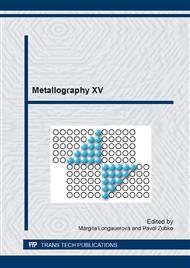p.197
p.201
p.205
p.209
p.215
p.221
p.227
p.231
p.235
Changes in Mechanical Properties and Microstructure after Quasi-Static and Dynamic Tensile Loading
Abstract:
Dual phase (DP), interstitial free (IF) and advanced high strength low alloy steel (HSLA)sheets have been successfully used for different components of car body. DP and HSLA are used ascrash resistant and IF as cover or “skin” of car body. The development of new vehicles nowadays isbeing driven by the need to simultaneously reduce mass and increase of passenger and pedestriansafety as well as costs saving through cold forming instead of hot forming. Limited publishedinformation is available on the changes in microstructure of these steel grades at different highstrain rates [1-3].This paper deals with changes of mechanical properties, microstructure and fractography of threesteel grades, which were tested at quasi static (10-3 s-1) and high strain rate (3000 s-1). Themicrostructures were characterized in terms of ferrite grain size, aspect ratio of ferrite andelongation of constituent phases. Deformed and undeformed specimens were compared to assess thechanges in the microstructure. The fracture appearance analysis indicates that the fracture patternunder high strain rates is mainly ductile, regardless of steel grades. The microstructure changessignificantly during the deformation process under both quasi-static and dynamic tension in allinvestigated steels. The plastic deformation in ferrite dominates in this process.
Info:
Periodical:
Pages:
215-218
Citation:
Online since:
April 2014
Authors:
Keywords:
Price:
Сopyright:
© 2014 Trans Tech Publications Ltd. All Rights Reserved
Share:
Citation:


